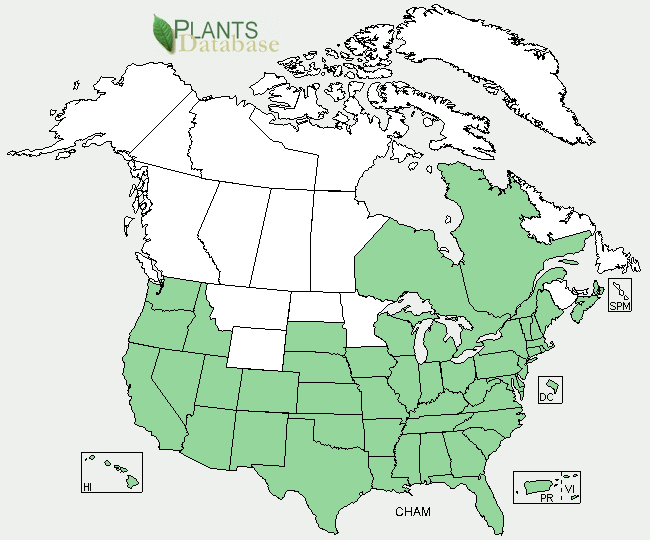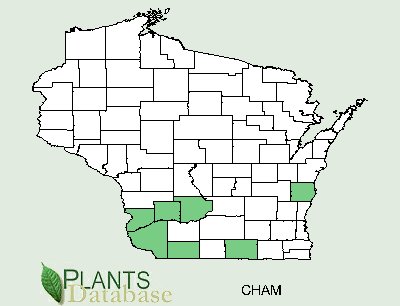Habitat
Chenopodium ambrosioides is a plant that is originally native to Mexico and the tropics of Central and South America. However, now this plant can be found worldwide in the oddest of places due to the introduction by people to many different areas of the world. The survival of this plant in different locations is also possible due to the fact that it is extremely ecologically tolerant, meaning this plant can endure a wide range of climatic conditions and still grow and prosper. See Adaptations for more information on how this is possible.
Focusing more on this plants incredibly versatility this plant can grow on every continent excluding Antarctica. It is just as likely to grow in wetlands as it is in non-wetlands and is known to grow best in full to partial sun exposure. Chenopodium ambrsodioides tends to grow well in soil with an abundance of nitrogen, however, this plant can adapt readily to many soil types. It can occur anywhere from 0-4060 feet in elevation, which is quite an incredible spread of distribution for such a small shrub-like plant. For a distribution map of the places Chenopodium ambrosioides can be found world-wide click here. Here in the states it is often found on the sides of roads, in vacant lots, yards, waste areas, fields, and for this reason it is often referred to as an invasive plant species, or more commonly referenced, a weed.

Above: All states in green are states in which the plant
Chenopodium ambrosioides can be found.
Not everyone sees this plant as the traditional ‘weed,’ there
are plenty of people worldwide who choose to plant this flowering
plant in their gardens. Some may choose to do this because the plant
tends to have a very peculiar odor that some find pleasing while
others may choose to plant it because it is a flowering plant
with a very unique look. So how
can a plant be used in a garden, but also be considered a weed? This
plant is an invasive species which means that it will re-sow itself
and may end up popping up in areas it is not wanted. Being
considered an invasive species, or ‘weed’ really has nothing to do
with how beautiful the plant is. After all isn’t beauty in the eye
of the beholder?
Let's take myself for instance. At the start of my research I
honestly had no idea what this plant looked like or any of the
amazing things it can be used for, see my
Fun Facts page for more detail, but I digress.
As I was saying this plant was a mystery to me, but as my research
continued I stumbled across a map that broke down where Chenopodium
ambrosioides can be found in each county of my home state of
Wisconsin. By just taking one glance of the map shown to the
left I could clearly see that this plant is found in only seven
counties in Wisconsin, and I happen to live in one of these areas.
After this revelation I thought back to summer days at my house and
realized that this plant could quite possibly be the plant that I
both see and smell for a great deal of the summer. It is really very
amazing to me that this plant was literally right under my nose my
entire life, and I had no idea. If you would like to check out
another flowering plant that can be found growing in Wisconsin take a look at
Echinacea purpurea, better known as the Purple Coneflower.
stumbled across a map that broke down where Chenopodium
ambrosioides can be found in each county of my home state of
Wisconsin. By just taking one glance of the map shown to the
left I could clearly see that this plant is found in only seven
counties in Wisconsin, and I happen to live in one of these areas.
After this revelation I thought back to summer days at my house and
realized that this plant could quite possibly be the plant that I
both see and smell for a great deal of the summer. It is really very
amazing to me that this plant was literally right under my nose my
entire life, and I had no idea. If you would like to check out
another flowering plant that can be found growing in Wisconsin take a look at
Echinacea purpurea, better known as the Purple Coneflower.
As mentioned above this plant is considered invasive and seems to grow well around the world under a plethora of conditions. So what kind of role(s) does this plant play in the environments that it calls home? The role it plays truly depends on the area in the world in which you encounter this plant. In some areas of the world it is nothing more than a weed or plant used in the garden, but some people rely on this plant for more than just the average uses of a plant, see Medicinal uses.